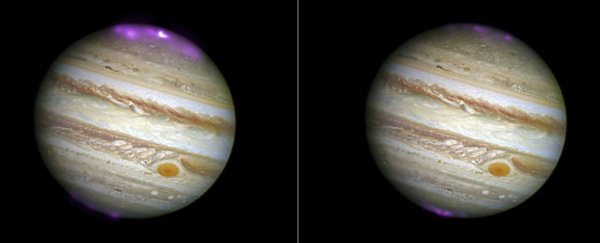Though the Northern Lights on Earth are undoubtedly beautiful, they're nothing compared to the amped-up X-ray version found on Jupiter. And now, astronomers in the UK have finally figured out what causes them: crazy solar storms.
First, for the uninitiated, let's talk about what creates the Aurora Borealis - Earth's Northern Lights. Basically, aurorae - on any planet - are caused when charged particles from the Sun interact with planetary magnetic fields. The different colours are produced by different ions. On Earth, this means aurorae are best seen from the Northern Hemisphere in areas like Siberia, Iceland, Alaska, and Canada.
While we look up in wonder at this spectacle in the night sky, there's an insane version of the same thing happening on Jupiter. In fact, Jupiter's X-ray aurora covers an area bigger than the surface of Earth.
We've known about Jupiter's version of the Northern Lights for a long time now, but researchers from University College London report being the first to witness how it changes when a solar storm moves in.
"When giant storms erupt, the winds become much stronger and compress Jupiter's magnetosphere, shifting its boundary with the solar wind 2 million kilometres through space," the team explains. "The study found that this interaction at the boundary triggers the high energy X-rays in Jupiter's Northern Lights."
To come to this conclusion, the team used NASA's Chandra X-Ray Observatory to monitor the amount of X-rays emitted by the planet for two 11-hour stretches in October 2011 as a solar storm overtook the gas giant.
With that data in hand, the team constructed an image to see where all of these X-rays were forming. As it turns out, they stemmed from mainly the northern and southern magnetic poles.
 Artist's concept of Jupiter's magnetosphere interacting with the solar wind. Credit: JAXA
Artist's concept of Jupiter's magnetosphere interacting with the solar wind. Credit: JAXA
William Dunn, the study's lead author, explains the team's reasoning:
"In 2000, one of the most surprising findings was a bright 'hot spot' of X-rays in the aurora which rotated with the planet. It pulsed with bursts of X-rays every 45 minutes, like a planetary lighthouse.
When the solar storm arrived in 2011, we saw that the hot spot pulsed more rapidly, brightening every 26 minutes. We're not sure what causes this increase in speed but, because it quickens during the storm, we think the pulsations are also connected to the solar wind, as well as the bright new aurora."
Besides offering new insights into how Jupiter's X-ray aurorae form, the findings have far wider-reaching implications, because understanding how 'space weather' affects planets is vitally important to Earth's future. Also, findings like these can help us understand how planets form, and how different atmospheres could support life.
To make it even more important, the findings will directly aid NASA's Juno spacecraft that's on schedule to reach Jupiter some time this summer. It's going to be exploring its magnetic field, aurorae, and atmosphere, ultimately so scientists can figure out how Jupiter, the second cosmic body in our Solar system, formed.
You can check out the team's full report in the Journal of Geophysical Research - Space Physics.
